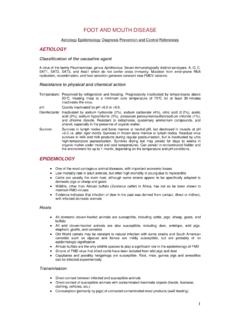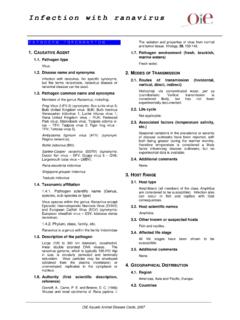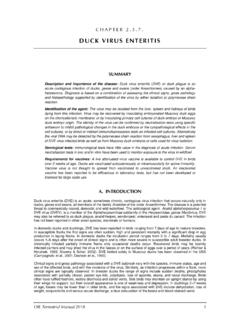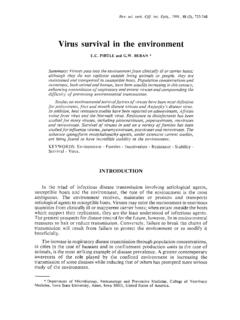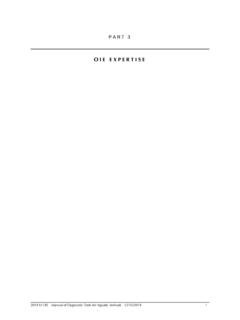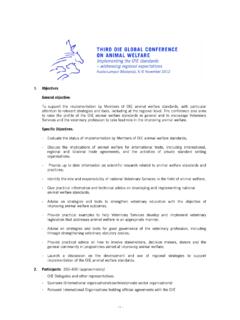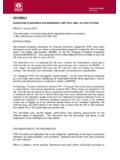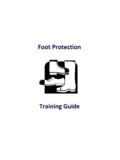Transcription of Foot & Mouth Disease - Home: OIE
1 foot & Mouth Disease Questions & Answers What is foot and Mouth Why must Member Countries Disease (FMD)? and Territories of the OIE comply with reporting requirements? FMD is a highly contagious viral Disease of cloven-hooved animals with signi cant economic impact, in cattle and swine as well as foot and Mouth Disease is acknowledged as a Disease with severe sheep and goats. In wildlife, all species of deer and antelope trade implications for the affected country. The cost of preventing are susceptible to FMD with some of them such as the African a sanitary crisis of animal origin by early detection of outbreaks buffalo, acting as carriers of the virus without showing clinical and implementation of rapid response mechanisms included symptoms.
2 In a susceptible non-vaccinated population, morbidity in national veterinary surveillance systems are insigni cant (the number of animals that will get the Disease ) could be as high compared to the social, economic and environmental cost of a as 100%. The Disease is rarely fatal in adult animals but mortality disaster resulting from an outbreak of foot and Mouth Disease . can be high in young animals. Early reporting protects and improves a country's reputation and gives it the assurance of a reliable trading partner. Implementation of these measures will subsequently reduce the degree of economic loss and loss of livelihood for a Member Country.
3 What causes foot and Mouth Disease ? The OIE assists especially developing and transitional countries to identify their ability to comply with international standards The virus which causes FMD is an aphthovirus of the family to control outbreaks of FMD. This is done by assessing the Picornaviridae. There are seven immunologically distinct types of performance of the veterinary services through application of FMD viruses, A, O, C, SAT1, SAT2, SAT3, and Asia1. There can the PVS tool by selected OIE experts in collaboration with the be a variety of genotypes within each of these requiring a speci c veterinary authority of a country.
4 Vaccine effective against the circulating viral eld strain in the event of an outbreak, to ensure protection. Where is the Disease found? What are the requirements for reporting FMD is endemic in several parts of Asia, a large part of Africa FMD to the OIE? and the Middle East. In Latin America, the majority of countries applied zoning and are recognized free of FMD with or without FMD is among the list of diseases that must be noti ed to the OIE vaccination, and the Disease remains endemic in only a few by Member countries and Territories. The following criteria guide countries or regions within certain countries.
5 Members in determining what events are considered signi cant Australia, New Zealand and Indonesia, Central and North America and require immediate noti cation (within 24 hours): and Western Europe are currently free of FMD. However, FMD. - the rst identi cation in a country or zone of an OIElisted can occur sporadically in typically free areas. Disease or infection Of the OIE Member Countries and Territories, 65 are recognized - the re-occurrence of a listed Disease or infection following a as free from FMD without vaccination; 1 country recognized as report by the Member indicating that the previous outbreak(s) free with vaccination.
6 Several other countries are recognized as had been resolved having zones that are free with or without vaccination. Over 100. - the rst occurrence in a country or zone of a new strain of a countries are still not considered as FMD free. pathogen of a Disease listed by the OIE. When an epidemiological event as described above occurs, the relevant Member must send an immediate noti cation to the OIE. What is the public health risk associated As the control measures are put in place, the affected country with this Disease ? must send follow-up reports describing progress and results of the applied control measures.
7 When the incident is over, a nal FMD is not readily transmissible to humans and is not a public report must be submitted once the Disease has been controlled health risk. Only a few benign cases of human infections have and as long as there are no new reported outbreaks. been documented, none requiring hospitalisation. These infections resulted from direct contact with infected animals. The infection in humans can be characterised by mild symptoms notably blisters on the hands and in the Mouth . -1- foot & Mouth Disease Questions & Answers How is FMD transmitted and spread? The elements included in a response effort to eradicate the Disease are: FMD virus is found in all excretions and secretions from an - surveillance and tracing of potentially infected or exposed infected animal.
8 It can spread easily and rapidly by means of the livestock;. following: - slaughter of infected animals using humane methods complying - introduction of new animals carrying the virus (saliva, milk, with OIE international standards on animal welfare;. semen, etc.) to a herd; - appropriate disposal of carcasses and all animal products in - use of contaminated pens, buildings or vehicles to house and compliance with OIE guidelines;. transport susceptible animals; - strict quarantine and controls on movement of livestock, - use of contaminated materials such as hay, feed, water, milk or equipment, vehicles, and biologics - wearing contaminated clothing or footwear, or using - thorough disinfection of premises and all infected material contaminated equipment - feeding susceptible animals with (implements, cars, clothes, etc.)
9 ;. animal products, raw or improperly cooked food, infected with - under certain conditions, complementary use of strategic ring the virus; vaccination. - dissemination of virus by aerosols transported from an infected property via air currents - accidental release of virus from a laboratory;. - use of vaccines containing live virus due to production errors in manufacture. Why do import bans include animal products and foods? Is there a food safety issue? What are the clinical signs of FMD? All products obtained from an infected animal or coming into The severity of clinical signs will depend on the strain of virus, contact or proximity with them must be considered contaminated.
10 The age of the animals and the species and breed affected. The The ban on products of animal origin and food products derived typical clinical sign is the occurrence of blisters (or vesicles) on from animals is justi ed by the possible presence of the virus the muzzle, tongue, lips, Mouth , between the toes, above the in these products and the risk of contamination of susceptible hooves, teats and potential pressure points on the skin. Ruptured animals, (not people). The OIE has de ned standards for the blisters in the interdigital space can result in extreme lameness inactivation of virus present in meat, milk for human or animal and reluctance to move or eat due to vesicles in the Mouth .
